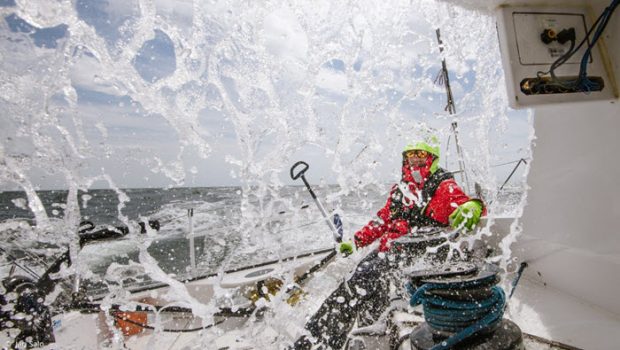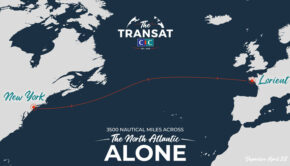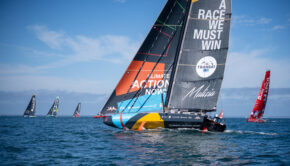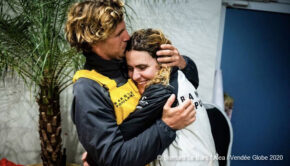Armchair assessment of IMOCA action
Published on November 12th, 2018
(November 12, 2018; Day 9) – With the battle in the Ultime category now decided, there remain five other classes vying for the podium in the 11th edition and 40th anniversary of the Route du Rhum-Destination Guadeloupe solo transatlantic race.
But some classes get more shine than others, and the spotlight now burns brightest on the IMOCA fleet so well established in premier shorthanded competition. The chase is on after leader Alex Thomson but in this race, nothing is certain until the finish line is crossed.
Out of the twenty 60-foot IMOACAs that left Saint-Malo on November 4, sixteen are still gripping the bone. Roland Jourdain, twice winner of the Route du Rhum, offers his armchair assessment of the action:
As spectators, we are being spoilt in the IMOCA class. There is a great line-up of foilers (from various generations) and non-foilers. It’s a fascinating contest to watch. We can more or less follow what is happening live with the tracker updated every hour. The problem is that it can take up your whole day.
Looking at the trade winds on the weather charts from ashore always gives the impression that it is easy sailing. That is, however, far from being the case, as the wind is rarely stable in strength and direction. It is often very hot, which drains your energy. The point of sail the leading boats are currently in is far from simple.
Alex Thomson, Paul Meilhat, Vincent Riou, Yann Eliès and indeed Boris Herrmann are sailing downwind trying to find the best VMG (Velocity Made Good, the perfect compromise between bearing and speed). This is a point of sail we don’t look forward to, particularly as you have to spend hours at the helm. Autopilots may be excellent, but they don’t offer their best performance in these conditions.
You also have to plan gybes. The lads must be working flat out. Under gennaker, the boat stays on course more than under spinnaker downwind, where it can be quite scary. The rule is that the more sail you have up front, the worse you sleep.
There are still a number of hurdles to avoid before the finish: the squalls as they approach the islands with all the seaweed, crab pots, and anything else that you cannot foresee in our line of work. You have to remain fully alert.
For the moment, Alex Thomson appears to be in control of the situation. It is true that he is unable to keep his opponents in the south and north in check at the same time. But when it is like that, you keep an eye on those that are closest, which in this case means Paul, Vincent and Yann.
Alex has a strong lead, but he is going to feel the pressure on him from behind right up to the finish. As we saw with the Ultime boats, potentially everything can change. You really have to think twice before making any forecasts or saying what you think is going to happen.
The more miles Alex puts between himself and his rivals by the Tête à l’Anglais island (located to the north of Basse-Terre), the better it will be for him, as sailing downwind of Guadeloupe is like the famous Chinese water torture.
In 2006, when I won in the IMOCA class for the first time, I had a lead of at least 120 miles over Jean Le Cam at Tête à l’Anglais island. But with the wind shadow from the main island and the trade winds disappearing, I found myself becalmed. The wind strengthened from behind, which allowed Jean to catch up. In the end, I reached Pointe-à-Pitre just twenty minutes before him. When I crossed the line, I could already see his mast lights arriving.
This year, if the same thing happens to the IMOCAs that we saw with the Ultimes, our blood pressure will be rising to very high levels. Until the finish, there is going to be something to keep us enthralled in terms of who wins and who makes it to the podium.
It’s no surprise that we find Alex, Paul, Vincent and Yann in front. They are after all the star pupils. We would have also liked to have seen Jérémie Beyou on the brand new Charal
up with them to compare the speeds, but they were forced out on day two.
The little group further back is logical too. It’s nice to see Alan Roura, Damien Seguin, and Stéphane Le Diraison fighting it out. It’s interesting to compare three similar boats, remembering that Alan has added foils, unlike Damien and Stéphane. We’ll also see whether Arnaud Boissières with an updated boat will shine and catch them up.
I don’t know Erik Nigon and Ari Huusela, so they’re a bit of surprise for me. It’s great to see them keeping up with the others like that. The wide range of backgrounds is one of the nice things about the IMOCA class.
Wherever you look on the tracker, there are battles going on and there is plenty to learn. It is hard even from ashore to be detached from the Route du Rhum. From time to time, I imagine myself out there with them. It really makes me want to be out there.”
Some of Roland Jourdain’s achievements in the IMOCA class
– Twice winner of the Route du Rhum (in 2006 and 2010)
– Three attempts at the Vendée Globe (3rd in 2000-2001)
– Winner of the 2001 Transat Jacques Vabre (with Gaël Le Cléac’h)
– 2nd in the 2005 Transat Jacques Vabre (with Ellen MacArthur)
– 2nd in the 2003 Transat Jacques Vabre (with Alex Thomson)
Event details – Ranking – Tracker – Facebook
Background: The 11th edition and 40th anniversary staging of the Route du Rhum-Destination Guadeloupe solo transatlantic race got underway on November 4. This iconic 3,542-nautical mile course will take the record entry of 123 skippers in six divisions from the start off the Brittany port of Saint Malo (France) to Guadeloupe.
Source: Route du Rhum-Destination Guadeloupe










 We’ll keep your information safe.
We’ll keep your information safe.